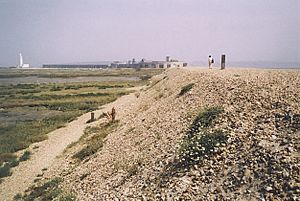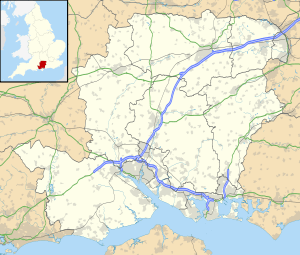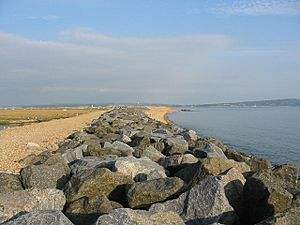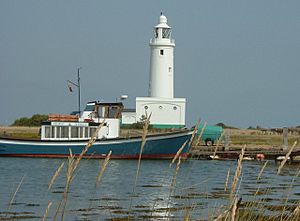Hurst Spit facts for kids
Quick facts for kids Hurst Spit |
|
|---|---|

Hurst Spit, looking east towards the lighthouse and castle
|
|
| Location | Hampshire, England |
| OS grid | SZ316897 |
| Coordinates | 50°42′23″N 1°33′04″W / 50.7063°N 1.5511°W |
Hurst Spit is a long bank of small stones and pebbles, about 1.6 kilometers (1 mile) long. It's located near the village of Keyhaven on the south coast of England, right at the western end of The Solent. This natural barrier protects an area of saltmarsh and mudflats called Keyhaven and Pennington marshes. At the very end of the spit stands Hurst Castle, a historic fortress first built by King Henry VIII. A tall Hurst Point Lighthouse was also built there in the 1860s to guide ships.
Contents
Exploring Hurst Spit's Geography
Hurst Spit is shaped like a hook and stretches about 2.2 kilometers (1.4 miles) from the Hampshire coastline into The Solent, pointing towards the Isle of Wight. This spit acts like a shield, protecting a special natural area known as the Hurst Castle and Lymington River Estuary. You can reach the end of the spit by taking a seasonal ferry from Keyhaven or by walking along the footpath, which is part of the Solent Way.
The sea around Hurst Spit can be tricky for boats. The narrow gap created by the spit makes the tides very strong. This can cause choppy waves and swirling water. There's also a hidden sand bar called The Trap, which sticks out about 60 meters (200 feet) into the Solent, just east of Hurst Castle. Sometimes, after big storms, old military shells that were fired during practice long ago are uncovered on the spit.
How Hurst Spit Was Formed: Geology
Hurst Spit was naturally formed from loose flint pebbles. These pebbles broke off from cliffs further west along the coast. Over time, ocean currents carried them here. However, since the 1940s, the spit has been getting smaller. This is because new coastal protection projects in Christchurch Bay stopped the flow of new pebbles reaching the spit.
In 1989, the spit became so weak that it was in danger of breaking apart completely. To fix this, a big project took place in 1996-1997. Workers rebuilt the pebble bank using shingle brought in from other places. They also built new rock defenses using strong larvikite rocks, which were shipped all the way from Norway. These rocks were placed at the western end of the spit and near the castle. The spit still needs to be reinforced from time to time, especially after big storms. For example, after the severe winter storms in 2013-14, parts of the spit had to be rebuilt and strengthened. Because of all this work, Hurst Spit no longer looks completely natural; it now looks "more like a railway embankment."
Sometimes, fossils from the Barton Beds can be found among the pebbles, but they are quite rare now.
Amazing Wildlife of Hurst Spit
Hurst Spit is home to many important saltmarsh plants. You can find plants like sea purslane (Halimione portulacoides), different types of glasswort (Salicornia species), annual seablite (Suaeda maritima), and golden samphire (Inula crithmoides).
Behind the spit, there's a large area of saltmarsh and mud flats called Keyhaven and Pennington marshes. These marshes are full of different kinds of wildlife, especially birds, insects, and plants. You might see large groups of black-headed gulls and dunlins. Many wading birds also visit, such as oystercatchers, ringed and grey plovers, and redshanks.
Rarely, Glanville fritillary butterflies have been spotted on the spit. They are usually just blown there by the wind.
Hurst Spit's Rich History
The name "hurst" likely comes from an old English word meaning "sandbank" or a small hill. Not much is known about Hurst before the castle was built. However, a document from 1434 might mention it, talking about a shipwreck near "Hurst."
Hurst Castle: A Royal Fortress
Hurst Castle was built between 1541 and 1544 by King Henry VIII. It was part of his plan to protect England's coast from possible invasions by France and Spain. Hurst Castle was specifically built to guard the western entrance of The Solent. During the English Civil War, the castle was taken over by Parliamentary forces. In late 1648, King Charles I was even held prisoner there. The castle was made much bigger in the 1860s, with two large sections added to hold powerful cannons. Soldiers were stationed at Hurst Castle until as recently as World War II.
Lighthouses Guiding Ships
The first lighthouse at Hurst, called Hurst Tower, started shining on September 29, 1786. It was located southwest of Hurst Castle. Later, in 1812, a taller lighthouse called the High Lighthouse was added.
These early lighthouses were eventually taken down and replaced by two new ones built in the 1860s. One was the "Low Light," built into the back wall of the castle's west wing. This was later replaced by a nearby iron lighthouse in 1911. The other new lighthouse was the "High Light" – the tall, freestanding Hurst Point Lighthouse that you can still see today. It was built at the very end of Hurst Spit between 1865 and 1867.
Other Buildings and Activities
In the 1700s, a small group of houses and an inn grew up just outside the castle. These buildings served the soldiers and their families. The inn was called The Shipwright's Arms. People said that in the summer, many visitors came because it was a lovely spot by the sea. This inn was torn down when the castle was expanded in the mid-1800s. However, by the 1870s, a new inn called the Castle Inn opened. It served the soldiers and the crews of ships that collected shingle (small stones) from the beach to take to places like Portsmouth and Southampton. The inn was still open in the early 1900s.
There was also a coastguard station near the castle by 1878, with a team of four men and a chief. They also had a place for small boats called "smacks" that collected special rocks called septaria nodules from the nearby coasts. These rocks were used to make a type of cement.
A small dock, originally made of stone, was built in the early 1850s to help with the castle's new construction. In the 1880s, a special narrow-gauge railway was built to move supplies and ammunition from the dock to the castle. You can still see parts of its track today.
Images for kids
-
The Castle and Lighthouse from the north west. The Needles can be seen in the distance.








